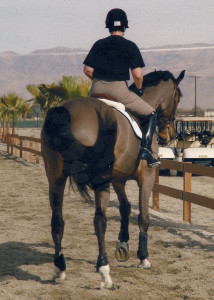Hunter, Jumper & Dressage Horse Trainer in San Diego, California. Arlyn DeCicco Offers Mobile Service for Novice Through Grand Prix Levels.
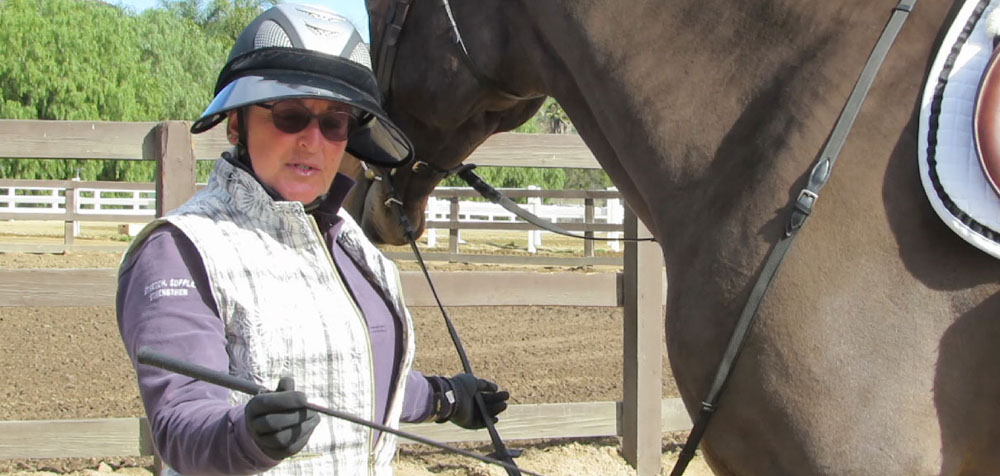
Arlyn teaches; “Your horse is your dance partner.” during a lesson and demonstration.
Stretch, Supple, Strengthen
The philosophy of Stretch, Supple, and Strengthen (SSS) is the key to proper development of the horse. By adhering to the exercises involved with SSS, riders can help their horse perform to the best of their ability. Using these methods will lead to a more relaxed, capable, and willing partner in all riding endeavors.
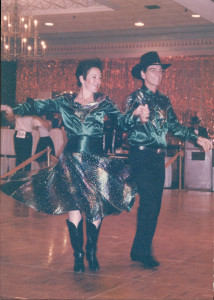
Just for fun- a picture of Arlyn dancing with her non-equine partner 🙂
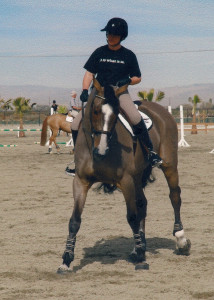
Moving in rhythm & balance creating a graceful flow of energy… dancing!
The following is quick overview of each phase.
Phase 1: Stretch
Stretch is the first vital phase in the Stretch, Supple, and Strengthen process. In the beginning of this phase, the horse is asked to lengthen it’s stride in the walk and stretch it’s neck as long as possible. Once the horse is comfortably swinging in the walk, they begin to breathe and function aerobically. This aerobic exercise puts less stress on the horse’s muscles, joints, and heart and allows the horse to use itself more completely in a relaxed manner. By allowing the neck and head to stretch down, the horse can lift its back and propel itself forward more correctly from the hind end. In technical terms, the horse is asked to lengthen its anterior and posterior muscles while the medial and lateral musculatures are also stretched. Once the horse has experienced the rewards of this phase, they will be asked to repeat these movements in every gait and stage of work. The Stretch phase of SSS helps to relax the horse and prepare them for the upcoming phases of Supple and Strengthen. Before and during phase 1, the horse’s mouth is either educated or ‘re-educated’ to the bit. It is my hope that the person who will be riding the horse is present for this part of the journey because the long term success of the horse will depend upon the education of the rider’s hands, seat and legs.
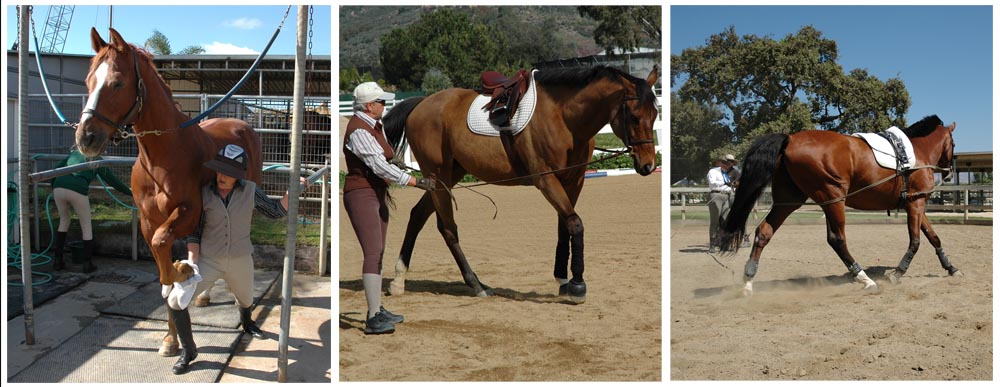
Stretch, Supple, Strengthen begins with body work to help the horse ‘unlock’, an introduction to the line and eventually long line-ing the horse regularly. The benefits of the long line far exceed those of the lunge line, however require tremendous skill and precision.
Phase 2: Supple
In the Supple phase of SSS, the horse is asked to move on a circle. The horse may then be asked to lengthen the outside muscles and shorten the inside muscles or, alternatively, to shorten the outside muscles and lengthen the inside muscles. More complicated suppling exercises involve leg yields in which the horse is asked to move away from the inside leg and rein. By bending the horse’s neck and body through these movements, the horse opens up their rib cage. This will allow them to breathe more easily, once again contributing to the wellness and performance of the horse. This phase is especially useful with horses that may be unwilling or unable to stretch fully in the first phase of SSS. After using the suppling exercises, the horse will be free to stretch and use itself more properly.
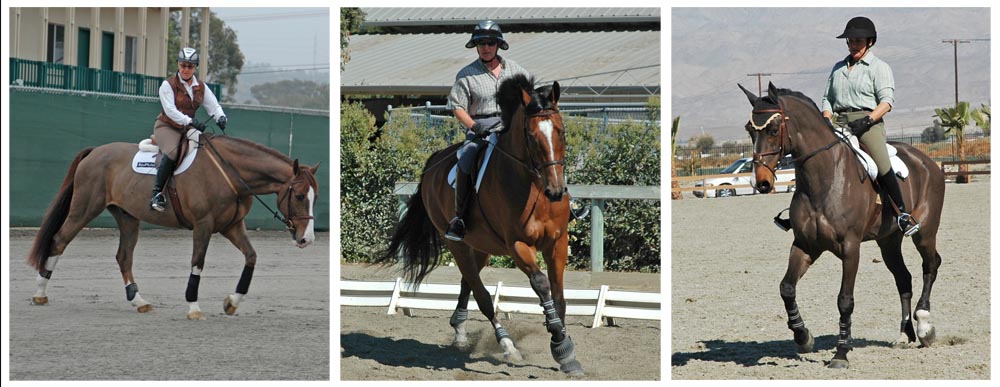
After the horse learns to stretch (made longer or wider without tearing or breaking), phase 2 teaches the horse to become more supple. Training the horse to become supple (bending and moving easily and gracefully; flexible) will allow the horse to enter phase 3- the strengthening program. During all three phases the horse’s well being is of paramount concern.
Phase 3: Strengthen
Strengthen is the final phase of the SSS routine and should only be attempted after the other two phases have been completed. The object of the Strengthen phase is to build muscle and strength in the horse. The Strengthen phase can involve riding on varied terrain and work with cavalletti and trot poles. For more advanced exercises, horse and rider can move on to work with gymnastic grids and jumps or the collected, medium, and extended gaits. Each horse’s physical development and mental acuity must be taken into account when developing a Strengthen program.
Four Phases of Musculature
Understanding the horse’s anatomy is crucial in training. A horse’s body is extremely complex, and a rider must have an understanding of the horse’s musculature in order to know how to supple, stretch, and strengthen each muscle group properly. By training a horse incorrectly, one muscle might unknowingly be developed to inhibit the use and movement of another muscle.
The four phases of the musculature that will be discussed are anterior, posterior, medial, and lateral. In understanding these four different areas, a rider can understand how to develop a horse correctly and how the four phases interact with one another to create the whole horse.
Anterior/Posterior Musculature
The anterior and posterior phases of the musculature refer respectively to the muscles in front and back. These muscles include those along the top and bottom lines of the horse, muscles in the front and back of the legs, and any muscles that work in a swinging motion.
While many riders may have heard or used the expression ‘riding from front to back’ when referring to a rider that is not allowing the horse to move forward from the hind end, few understand how this type of riding relates to the horse’s musculature. If a rider does not encourage a horse to work forward from the hind legs or refuses to stretch the anterior and posterior muscles correctly, the horse’s movement and performance will be inhibited. Without proper management of the anterior and posterior muscles, the horse’s performance and ability to flex will be limited. This will result in lack of adjust-ability and possible injury.
Medial/Lateral Musculature
The medial and lateral phases of the musculature refer respectively to the middle and outside muscles of the horse. These muscles are located on the sides of the horse and are used when the horse is asked to bend or move laterally.
In order to optimize the medial and lateral muscles, a rider must supple them. This can be done through lateral and bending exercises where the horse is asked to open up and breathe. Once the horse’s muscles are supple and relaxed, the horse will be able to more easily complete the rider’s requests. If a rider does not properly supple the medial and lateral muscles and begins strengthening prematurely, the horse’s range of motion will be severely restricted. This will result in stiffness, resistance to the rider’s commands, and inability to perform.
Rider Position
A rider’s own physical state plays a large role in the proper development and balance of a horse. An unbalanced or uneducated rider will often interfere with the horse’s balance and hinder their development. To prevent this negative interference, the rider must make a commitment to their own personal development. Stretching and suppling exercises for the rider with and without an exercise ball can be used to correct imbalances and assist riders in their ability to flow with their horse. Without proper education of the seat, leg, and hand, a rider will not have the tools required to properly stretch, supple, and strengthen their horse to create the best athlete possible. A horse is only as good as its rider; therefore, it is imperative that the rider gain the education necessary in order to refrain from interfering with the horse’s range of motion. Once riders undertake this challenge, they will achieve the ability to more accurately and effortlessly lead their horse’s energy.
